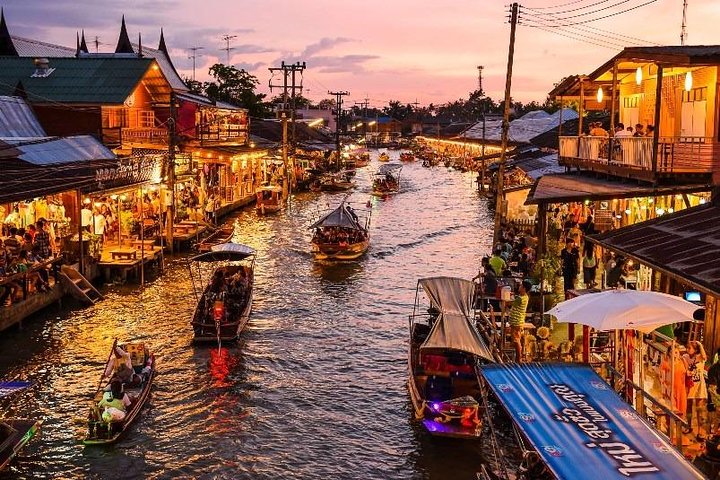Floating markets have long been one of the unique highlights of Southeast Asian culture. The region has a collection of floating markets that bring to life the uniqueness and cultural diversity of each country and region. From markets that sit on water to those that float on lakes and rivers, each floating market has its own story that reflects the way of life, traditions and cultural appeal of its place of origin.
In this article, we highlight some of Southeast Asia's most famous floating markets, each with its own unique characteristics. Each of these markets provides an in-depth look at how culture and economy have grown and developed in the region, and how they are places where daily life and culture blend in unique harmony.
1. Damnoen Saduak Floating Market, Bangkok, Thailand
Damnoen Saduak Floating Market, located in Damnoen Saduak district, Ratchaburi province, about 100 kilometers from Bangkok, is one of the famous floating markets in Thailand. The market offers a lively atmosphere and a wide variety of goods that attract tourists from all over the world. The market sells a wide variety of goods including fresh produce, local food, handicrafts and unique items.
Founded in 1981, the market has an interesting history after a new road was built along the Ton Canal to facilitate trade. Visitors can explore the market by paddle boat, navigating the small canals and feeling the pulse of local life. As well as being a top tourist destination, the market is often an option on day trip packages from Bangkok. On this visit, you'll not only get to shop, but also experience the vibrant traditional Thai life and culture.
2. Inle Lake Floating Market, Myanmar
Located on the surface of Inle Lake, this floating market is a symbol of its uniqueness and traditional lifestyle. The floating market at this location is quite different from other floating markets on rivers. This market is unique because it is on the lake.
Vendors paddle their boats along the surface of the lake, offering various products such as vegetables and rice that they grow and harvest themselves. There is also a special area in the form of a floating garden on the lake where locals harvest various types of vegetables such as tomatoes, eggplants, pumpkins and long beans. some fishermen also sell fresh fish caught directly from the lake. In addition, tourists have the opportunity to see and buy locally made handicrafts as souvenirs from the locals.
3. Muara Kuin Floating Market Banjarmasin, Indonesia
Muara Kuin Floating Market in Banjarmasin is one of the most famous floating markets in Indonesia. Visitors and traders at this location use traditional boats, called "jukung" in Banjar language, to transport and trade vegetables and garden produce from various villages scattered along the Barito River and its tributaries. This market, which is active from dawn to 7am, has some unique concepts associated with it.
One of them is the term used to describe the vendors. Female merchants who sell products made by themselves or their neighbors are called "dukuh", while individuals who buy from the dukuh for resale are called "panyambangan". In addition, the market still carries out the practice of bartering between traders, known as "bapanduk". This adds a special dimension to the character of this traditional market.
4. Cai Rang Floating Market, Viet Nam
Cai Rang Floating Market in Can Tho, Viet Nam is one of the largest and most famous floating markets in the world. Located about 6 km or a 30-minute boat ride from Ninh Kieu Pier, the market operates daily from sunrise to sunset, with the busiest time in the morning until 9:30 am.
In the morning, the waterway of the river becomes a maze with hundreds of boats and junks of all sizes docked along the kilometer-long stretch. All of these boats are carrying seasonal fruits and vegetables that the vendors buy for resale.
In this market, the vendors do not shout to market their goods. They use the "Cay Beo" or upright pole on the bow of the boat as a medium to display samples of their products. In this simple way, buyers can see from a distance what is being sold. This way of selling has been going on for over a hundred years, proving that the tradition is still strong in the lively and unique atmosphere of the floating market.
5. Amphawa Floating Market, Thailand
Amphawa Floating Market, also known as Amphawa Floating Market, is one of the long-standing floating markets in Thailand and is very popular with tourists. This floating market is also one of the main tourist destinations in Samut Songkhram. Due to its proximity to Bangkok, the market is often crowded with tourists on weekends from Friday to Sunday to enjoy the view of the canal while enjoying a delicious meal.
Visitors have the opportunity to purchase fresh seafood, Thai desserts and a variety of souvenirs for family and friends. In addition, boat tours are available for those who wish to explore the sights and lifestyle along the Amphawa Canal. At night, visitors can take a boat ride to see fireflies glittering among the mangrove trees, creating a mesmerizing night view.
These floating markets vividly depict the rich culture of each region and are an integral part of the cultural heritage that attracts many tourists from the region. Each floating market is a window into the traditional lifestyles and unique cultures that lie beneath the glittering surface of Southeast Asia.
























